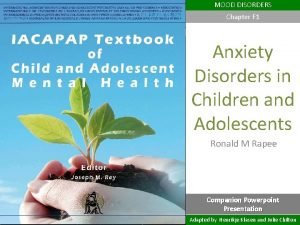Family Communication Coping and Internalizing Symptoms in Adolescents

- Slides: 1

Family Communication, Coping, and Internalizing Symptoms in Adolescents 1, 2 2 2, 3 Ashley Pantaleao, MA, Anna Vannucci, MS, Emily Simpson, MA, Juliet Bradley Ph. D, LSW, 4 Christine Mc. Cauley Ohannessian, Ph. D, 2, 5 University of Maryland 1, Connecticut Children’s Medical Center 2, University of Connecticut 3, Kaplan University 4, University of Connecticut School of Medicine 5 Results Background Ø The influence of family functioning, including communication, may help buffer against adolescent anxiety and depression. Ø Adolescent-parent communication has been shown to correlate significantly with adolescent self-esteem and positive or action based coping skills. Ø Adolescent-parent communication may function to enhance adolescent emotion regulation abilities through social support mechanisms. Objectives Ø Identify whether adolescents’ communication with their mothers and fathers differentially predicted internalizing symptomatology (i. e. , depression and anxiety). Ø To understand whether coping skills mediated these longitudinal relationships. Methods Participants: • 1, 036 10 th and 11 th grade students from suburban public high schools in the Mid-Atlantic region of the U. S. • 53% female; Baseline age: M =16. 15, SD=. 75 years. • Race/ethnicity: 58% non-Hispanic White, 23% African American, 12% Hispanic, 2% Asian, and 6% Other. Procedures: • Surveys were administered in seven public high schools during the spring of 2007 (Time 1), 2008 (Time 2), and 2009 (Time 3). Measures: • Parent-Adolescent Communication Scale: open and problem communication between adolescents and their mothers and fathers at Time 1 (α =. 87 -. 88). • COPE inventory: Dispositional use of coping strategies at Time 2, including: venting emotions, instrumental social support, active coping, denial, religious coping, humor, emotional social support, and planning (α =. 75 -. 90). • Center for Epidemiological Studies Depression Scale for Children: depressive symptoms in the past week at Times 1 (used as a covariate) & 3 (α=. 91). • Screen for Child Anxiety Related Disorders: total anxiety symptoms in the past 3 months at Times 1 (used as a covariate) & 3 (α =. 91 -. 94). This research was supported by NIAAA K 01 AA 015059. To obtain a copy of this poster, please visit adolescentadjustmentproject. org. Results Multiple group analysis Figure 2. Results for Girls Ø To determine if separate path models for the longitudinal analyses were needed for girls and boys, multiple group comparison analysis was conducted. Ø Parameter estimates varied by gender, as indicated by significant chi-square tests for the structural means, covariances, and residuals (X 2(38) = 67. 05, p <. 01; X 2(48) = 261. 25, p <. 001; X 2(52) = 338. 18, p <. 001; X 2(58) = 372. 50, p <. 001; X 2(97) = 478. 88, p <. 001) suggesting girls and boys should be examined separately. Ø Indices of model fit suggested that the specified model fit the data well when examining girls and boys separately (X 2(44) = 281. 23, p <. 001; NFI =. 94; CFI =. 94; RMSEA =. 06). Adolescent-Mother Communication Pathways • Greater adolescent-mother communication predicted - Higher anxiety symptoms (β=. 14, p<. 05). - Lower use of denial (β= -. 11, p<. 05) - Greater use of active coping (β=. 11, p<. 05), emotional social support (β=. 11, p<. 05), and humor (β=. 12, p<. 05). • Greater use of humor predicted lower internalizing symptoms (depressive symptoms: β= -. 17. p<. 01); anxiety symptoms: β=. 23, p<. 001), which was a significant mediator. Adolescent-Father Communication Pathways • No significant direct effects were found with internalizing symptoms. • Greater adolescent-father communication significantly predicted more religious coping (β=0. 14, p<. 05). Figure 1. Longitudinal Pathways for Boys Adolescent-Mother Communication Pathways • No significant direct effects were found with internalizing symptoms. • Greater adolescent-mother communication predicted more active coping (β=. 15, p<. 05), emotional social support (β=. 14, p<. 05), and planning (β=. 15, p<. 05). • No coping strategies predicted internalizing symptoms, nor did they mediate the relationship adolescent-mother communication and internalizing symptoms (ps >. 05). Adolescent-Father Communication Pathways • Greater adolescent-father communication predicted - Lower internalizing symptoms (depressive: β= -. 19, p<. 05; anxiety: β= -. 24, p<. 05). - Lower use of emotional social support (β= -. 13, p<. 05) and venting emotions (β= -. 16, p<. 05). • Greater use of venting emotions predicted higher internalizing symptoms (depressive: β=. 35, p<. 001; anxiety: β=. 35, p<. 01), which was a significant mediator. Conclusions Note: * p <. 05, ** p <. 01, *** p <. 001 Conclusions Ø Findings highlight the importance of adolescent-parent communication and specific coping skills in the etiology of internalizing symptomatology during adolescence. References Ø Consistent with social learning theory, the predictive relationships between communication and internalizing symptoms occurred across same-sex adolescent-parent. Ø Family-based interventions are warranted to prevent depression and anxiety in adolescents with coping skill targets tailored based on gender. Note: * p <. 05, ** p <. 01, *** p <. 001 Ø Boys’ relationships with their father and girls’ relationships with their mother may be particularly important to focus on during interventions.

